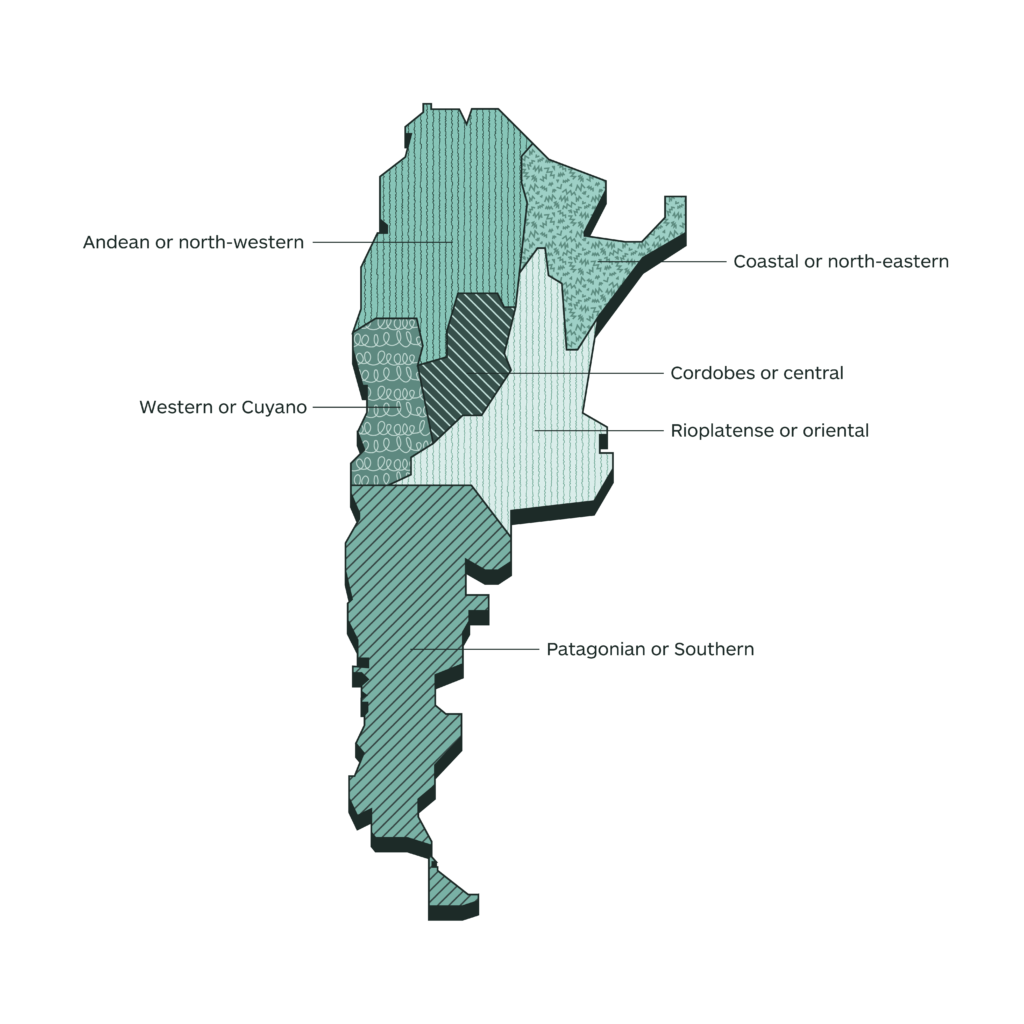South America
To which language should you translate to localize in Argentina?
What we know from our community
Argentina speaks one language: Spanish. The difference with the one used in Spain and most of Latin America is the “VOSEO”. This means that the formal use of addressing a person (“USTED”) is replaced by the informal form of address (“VOS”). So, if a headline reads: “USTED PUEDE GANAR” or “TÚ PUEDES GANAR”, it is clearly not intended for Argentina. Instead, it would read: “VOS PODÉS GANAR.”
Like most countries, there are differences in idiomatic expressions and inflections, mainly defined by geographic circumstances. For example, people from the Córdoba Province are well known for having a very distinctive accent (and also for drinking ridiculous amounts of Fernet). Up north, Salta and Jujuy have their own singular cadence and pronunciation, similar to that of Bolivia. Misiones Province, closer to Brazil, has its own funny intonation. And the rest of Argentina speaks pretty much similar to the Spanish you hear in Buenos Aires. There are a few dialects used mainly by indigenous communities.
LANGUAGE INSIGHT
Official language
Spanish (96%; 44.78 mln)
Actual languages
Spanish (96%; 44.78 mln), Italian (1.7%; 793k), Guaraní (0.5%; 233k), Quechua (0.2%; 93k), other (1.6%; 746k)
What the top 150 best localized websites in the world do in Argentina
(Top 150 websites listed in the Global by Design ranking – published annually by Byte Level Research, this report provides a list of globally localized websites, showcasing best practices and emerging trends in their globalization)
- 92/150 localize by translating into standard Spanish
- 13/150 localize by translating into the Argentinian variant of Spanish
- 3/150 localize by translating into LatAm Spanish variant
- 1/150 localizes by translating into both LatAm Spanish and Cymraeg
- 1/150 localizes by translating into LatAm Spanish, French and Simplified Chinese
- 1/150 localizes by translating into Spanish, French, German, Korean and Japanese
- 1/150 localizes by translating into Spanish, Italian, French, German, Portuguese, Japanese, Simplified Chinese, Traditional Chinese, Polish, Hungarian, Romanian, Bahasa Indonesia, Thai, Ukrainian, Russian and Turkish
- 1/150 localizes by translating into Spanish, Cymraeg, Nivaclé language, Guaraní, Quechua and Argentinian Sign Language
- 1/150 localizes by translating into Spanish, Cymraeg and Nivaclé language
- 1/150 localizes by translating into Spanish, Cymraeg, Guaraní and Quechua
-
3M
-
ABB
-
Accenture
-
Adidas
-
Adobe
-
Airbnb
-
Aldi
-
Amazon
-
American Airlines
-
American Express
-
Apple
-
Audi
-
Autodesk
-
Avis
-
Bayer
-
BMW
-
Booking.com
-
Bosch
-
British Airways
-
Bumble
-
Burberry
-
BYD
-
Canon
-
Capgemini
-
Cartier
-
Caterpillar
-
Chevrolet
-
Cisco Systems
-
Citibank
-
Coca-Cola
-
Costco
-
Dell
-
Deloitte
-
Delta
-
DHL
-
Disney+
-
Dyson
-
eBay
-
Eli Lilly
-
Emirates
-
Ernst & Young
-
Facebook
-
FedEx
-
Ford
-
Four Seasons
-
Fujifilm
-
GE
-
Gillette
-
GoDaddy
-
Google
-
Gucci
-
Haier
-
Heineken
-
Hermès
-
Hertz
-
Hilton
-
Hisense
-
Hitachi
-
Honda
-
Hotels.com
-
HP
-
HP Enterprise
-
HSBC
-
Huawei
-
Hyatt
-
Hyundai
-
IBM
-
IKEA
-
Intel
-
InterContinental Hotels
-
J&J
-
Jack Daniel's
-
Jehovah’s Witnesses
-
John Deere
-
Kellogg's
-
Kia
-
KPMG
-
L'Oréal
-
Land Rover
-
LEGO
-
Lenovo
-
Lexus
-
LG
-
Louis Vuitton
-
Lululemon
-
LUSH
-
Marriott
-
MasterCard
-
McDonald's
-
Mercedes-Benz
-
Merck
-
Microsoft
-
Mitsubishi Electric
-
Nestlé
-
Netflix
-
Nike
-
Nikon
-
Nintendo
-
Nio
-
Nissan
-
NIVEA
-
Oracle
-
Pampers
-
Panasonic
-
PayPal
-
Pepsi
-
Pfizer
-
Philips
-
Pitney Bowes
-
Porsche
-
Procter & Gamble
-
PWC
-
Revolut
-
Rolex
-
Royal Caribbean
-
Salesforce
-
Samsung
-
Sanofi
-
SAP
-
Sephora
-
Shopify
-
Siemens
-
Sony
-
Spotify
-
Starbucks
-
Steelcase
-
Stripe
-
Subaru
-
Tesla
-
The Church of Jesus Christ of Latter-day Saints
-
Tiffany
-
Tinder
-
Toshiba
-
Toyota
-
TripAdvisor
-
Uber
-
United Airlines
-
UPS
-
Visa
-
Volkswagen
-
Volvo Cars
-
Vrbo
-
Walmart
-
Western Union
-
Wikipedia
-
Wise
-
WordPress
-
Workday
-
Xerox
-
Xiaomi (Mi)
-
Zara
-
Zoom
If you need others information, below you can find a selection of economic/social/cultural data
Overview
Language
Official language
Spanish (96%)
Spanish, with 480 million native speakers and a thriving online population of more than 330 million, Spanish is the world’s second most common language after Chinese and far surpasses English.
T-index
0.91%
T-Index ranks countries according to their potential for online sales.
Other languages
Italian (1.7%), Guaraní (0.5%), Quechua (0.2%), other (1.6%).
Indigenous languages
Mapuche, Guarani, Aymara, Toba and Quechua.
English
High proficiency (EF) – 28 of 116 countries/regions in the world- 2/21 position in Latin America.
Demography
Capital: Buenos Aires
Currency: Argentine peso
Population: 45.65 mln
Population density: 17/km2
Economy
GDP: 646.08 billion USD (2023)
GDP per capita: 14,187.5 USD (2023)
Exports: $87.2 billion (2022)
Statistics
Internet users: 88.4% penetration, 40.58 million
Unemployment rate: 6.2% (2023)
Urbanisation: 92.46% (2020)
Literacy: 99.13% (2019)
Conventions
Numbering system
Arabic numerals and comma as decimal separator
Date format: dd – mm – yyyy
Time: 12h time system (a.m/p.m)
Country code: 0054
Language data sources: Worldatlas/Britannica//EF/Wikipedia; Demography data sources: IMF/Worldometers; Conventions data source: Wikipedia; Economy data sources: WTO/OEC/CIA/Esomar/Datareportal; Statistics data sources: Datareportal/WorldBank/UN/UNESCO/CEIC/IMF/Culturalatlas/Commisceoglobal/Worlddata.info
Facts and data
Economy
Imports
$76.9 billion (2022). Refined Petroleum ($6.79B), Motor vehicles; parts and accessories (8701 to 8705) ($3.58B), Petroleum Gas ($3.49B), Cars ($1.89B), and Soybeans ($1.67B), importing mostly from China ($16.4B), Brazil ($15.4B), United States ($11.1B), Germany ($2.69B), and Paraguay ($1.91B).
Financial inclusion factors (over 15 years of age)
• 66.3% have an account with a financial institution
• 28.9% have a credit card
• 35.1% have a mobile money account
• 24.3% make online purchases
Ease of doing business
Ease of conducting business is medium (rated 59 out of 100). Ranked 19th out of 32 Latin American and Caribbean countries. Ranked 126th out of 190 countries worldwide (2023, World Bank).
Exports
$87.2 billion (2022). Soybean Meal ($12B), Corn ($9.79B), Soybean Oil ($6.79B), Wheat ($4.77B), and Delivery Trucks ($4.53B), exporting mostly to Brazil ($12.6B), China ($8B), United States ($6.99B), Chile ($5.11B), and India ($4.38B).
In 2022, Argentina was the world’s biggest exporter of Soybean Meal ($12B), Soybean Oil ($6.79B), Ground Nuts ($818M), Bran ($480M), and Other Vegetable Residues and Waste ($331M)
Main local online stores
MercadoLibre, eBay and Amazon, Netshoes, Alibaba, Garbarino.com, Musimundo.com, Frávega, Apple and Cencosud
Economic freedom
‘Mostly not free’ (rated 49.9 out of 100). Ranked 27th out of 32 Latin American countries. Ranked 145th out of 186 countries worldwide (2024, Heritage Foundation and Wall Street Journal).
Global Innovation Index
Ranked 6th out of 19 Latin American and Caribbean countries, and 73rd out of 132 worldwide.
The Global Innovation Index captures the innovation
ecosystem performance of 132 economies and tracks the most recent global innovation trends.
Economy data sources: WTO/OEC/CIA/Esomar/Datareportal
Service Imports (2019)
Service Exports (2019)
Source: OEC
Trade balance of goods from 2012 to 2022
Source: Statista
Historical Data Trade Imports
The following section uses historical trade data imports from partners of Argentina.
Historical Data Trade Exports
The following section uses historical trade data exports from partners of Argentina.
Source: OEC
Argentina's Most Complex Exports
The Product Complexity Index (PCI) measures the knowledge intensity of a product by considering the knowledge intensity of its exporters.
The Top Export Opportunities for Argentina by Relatedness
Relatedness measures the distance between a country's current exports and each product by showing only products that Argentina is not specialized in.
Source: OEC
Argentina's Most Specialized Products
Specialization is measured using Revealed Comparative Advantage (RCA), an index that takes the ratio between Argentina observed and expected exports in each product.
Source: OEC
Perception of products made in selected countries in 2017
Source: Statista
Which attributes do you associate with products made in Argentina?
Source: Statista
Market Growth Imports (2019)
This score represents the likelihood that the given country will start importing that product in the next few years. It forecasts the opening of a new specific market.
Market Growth Exports (2019)
This score represents the likelihood that the given country will start exporting that product in the next few years. It forecasts the opening of a new specific market.
Source: OEC
Foreign direct investment, net inflows (% of GDP)
Source: WorldBank
Distribution of e-commerce sales in 2018 in Argentina, by method of payment
Sources: Kantar TNS; CACE

T-index
Reach most of the online purchasing power
T-Index ranks countries according to their potential for online sales. It estimates the market share of each country in relation to global e-commerce.
Try it nowMedia
Media language Spanish
Information channels
The Grupo Clarin and La Nacion conglomerates are the main players in the national media. The top free-to-air TV networks – Telefe, America, El Nueve and El Trece – are privately owned. Public broadcasting has a minor role. Clarin and La Nacion are the leading national newspapers. The government does not routinely block or filter online content, says Freedom House.
The press
Clarin – popular daily
La Nacion – respected conservative daily
Cronica – tabloid daily
La Prensa – Argentina’s oldest newspaper
Pagina 12 – left-wing daily
Television
Telefe (Canal 11) – leading national network, operated by Grupo Telef
El Trece (Canal 13) – leading national network, operated by Grupo Clarin
El Nueve (Canal 9) – popular national network
America (Canal 2) – popular network
Todo Noticias – cable/satellite news channel owned by Grupo Clarin
Radio
Radio Mitre – talk radio, operated by Grupo Clarin
Radio Nacional – public
Radio America – private, news and entertainment
Radio Continental – private speech-based network
Los 40 Principales – private FM music network
News agency
Telam – state-run
Noticias Argentinas – set up by privately-owned newspapers
Infobae – news portal
Media data source: BBC
Internet Data
Internet users
88.4% penetration, 40.58 million
Share of web traffic by device
58.15% mobile phones, 41.24% computers (laptops and desktops), 0.56% tablet devices and 0.04% other devices.
Median speed of mobile Internet connection
24.99 Mbps
Median speed of fixed Internet connection
75.89 Mbps
Mobile connection as a percentage of total population: 135.5%
Percentage of mobile connections that are broadband (3G-5G): 92.9%
Most popular web search engines
Google (97.88%), Bing (1.05%), Yahoo (0.85%), DuckduckGo (0.1%), Ecosia (0.1%), Yandex Ru (0.01%)
Most used social media
Facebook (82.65%), Instagram (6.8%), Pinterest (4.85%), Twitter (2.83%), YouTube (2.67%), Tumblr (0.13%)
Internet data sources: Datareportal/Statcounter
Social statistics
Life expectancy
76 yrs (2022)
Current health expenditure
9.71% of GDP (2021)
Current education expenditure
94.5% of total expenditure in public institutions
Gender
In recent decades, women have gained access to many positions in the job market as well as in politics, economics, etc. However, some constraints keep women from advancing within a more predominant male job culture and helps explain the small numbers of women at the top level of many organizations.
Corruption perceptions Index
Argentina scored 38 out of 100, ranked 94 out 180 countries worldwide.
CO2 emissions
4.06 metric tons per capita.
Religion
Generally speaking, Argentina is a Catholic country, with the presence of some minorities, such as the Jewish community (2% of the population, concentrated in the area of Buenos Aires) and other minorities such as Muslims. Religion does not usually have any particular impact in the workplace.
Ethnicity
85% of the population in Argentina has European origin and 15% are of mixed origin. Sometimes, discrimination due to physical appearance does arise.
World Happiness Index
Argentina ranked 57 out of 146 countries, with a score of 5.967.
Social statistics sources: WorldBank/UN/UNESCO/CEIC/IMF
Tertiary education in Argentina
Source: UNESCO
Tertiary education in Argentina, by sex
Source: UNESCO
The Data Factbook is a work in progress project. Our community is helping us to fill it up always with new and updated data. Your contribution is precious. If you want to help us, please write your advices at imminent@translated.com
Languages research
Dialectal variants of the Spanish language in Argentina

Legend
-
Andean or north-western
-
Coastal or north-eastern
-
Western or Cuyano
-
Cordobes or central
-
Rioplatense or oriental
-
Patagonian or Southern
The capital and largest city is Buenos Aires, an autonomous city that is the second-largest metro area in South America. Buenos Aires has a population of 3 million, with a metropolitan population of close to 13 million. 92% of Argentina’s population live in cities, with the 10 largest metro areas accounting for nearly half of the population.
10 top cities population in Argentina
| Buenos Aires | 13,076,300 |
| Cordoba | 1,428,214 |
| Rosario | 1,173,533 |
| Mendoza | 876,884 |
| San Miguel de Tucuman | 781,023 |
| La Plata | 694,167 |
| Mar del Plata | 553,935 |
| Quilmes | 518,788 |
| Salta | 512,686 |
| Santa Fe de la Vera Cruz | 489,505 |
The geographical distribution of languages that you will find in the maps published in this section is a work in progress. Our community is helping us to fill it up with always new and updated data. Your contribution is precious. If you want to help us, please write to imminent.factbook@translated.com
Photo credit: Juan Pablo Mascanfroni, Unsplash


